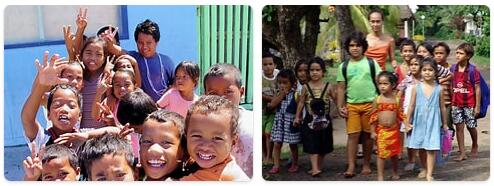
Yearbook 2004
Marshall Islands. On March 1, on the 50th anniversary of the US explosion of the hydrogen bomb Bravo over the Bikini Toll, memorial ceremonies were held in the Marshall Islands. The total population in Marshall Islands is 59,201 people in 2020. Between 1946 and 1958, the United States conducted a total of 67 test blasts in the atmosphere above the Marshall Islands, whose total force corresponded to thousands of Hiroshima bombs. Because of the radioactive radiation, cancer and other diseases are common, and many have still not been able to return to their islands.
During the year, the Marshall Islands dispute with the US continued to compensate for the damage. Under the Compact of Free Association, the United States has promised $ 270 million in compensation, some of which has been paid out. Since September 2000, the Marshall Islands government has been waiting for a response from the United States for a request for an additional $ 2 billion. In June, Marshall Islands President Kessai Note traveled to Washington to lobby for compensation. He also requested that the US Congress hold hearings on the nuclear tests.
At the beginning of the year, a health care program for the victims of the nuclear weapons tests was completed, which has existed since the late 1980s. The reason was that the US withdrew funding the year before, $ 2 million a year. Both politicians and civilians voiced strong criticism of the United States’ unwillingness to give the Marshall Islands full compensation, while the great powers spend much larger sums in Iraq and Afghanistan.

The islands are located on the path of the NE trade winds, which blow mainly from December to July: calm or westerly winds prevail in the rest of the year. Hurricanes sometimes form, especially in October and November: in June 1905, during one of these thunderstorms, the islands of Arno, Jaluit and Maiuro were significantly devastated. The rain, scarce in the northern islands, increases towards the S., where the vegetation is therefore more luxuriant and the population denser. In Jaluit the rain varies from 10 to 30 cm. per month (Finsch) and is rather uniform throughout the year. Even the thermal conditions in Jaluit are very uniform: the maximum monthly temperature oscillates between 30 °, 6 (January) and 32 °, 5 (August and September), the minimum between 25 ° and 27 °.
The flora is less varied than that of the Carolines and the Philippines, but generally similar to the latter. Chamisso found there only 59 species of plants. Very useful is Pandanus odoratissimus, which provides many products and of which there are 20 varieties. Coconut, breadfruit, banana, papaya and taro abound on the southern islands.
The fauna of the Marshall Islands, like in general the islands of Micronesia, is far from well known.
For the Vertebrates the scarcity of Mammals is remarkable, represented by some mice, in front of a fair amount of Birds. Among the marine ones, we will notice representatives of the Anatiforms and Ardeiforms more or less distributed throughout Oceania, similarly to some Ralliformes which in general, bad flyers and sedentary, have, as in the tropical islands, special representatives. Passerines, although numerous in western Polynesia, seem to be absent in the Marshall Islands. Reptiles are very poorly represented by some species of the group of Skincoids and Geckonids.
Among the terrestrial molluscs we note species of the group of Pupids, and of Limacids and Stenogyres, while the Helicides are missing.
The entomological fauna with various species of Lepidoptera from the group of Sphinxes and Geometrids, of Beetles represented by species of Carabidae, Coccinellidae, Tenebrionidae, Curculionidae, Longicorns and Hymenoptera of the Fomicidae group is discreet.
The main center, Jaluit, has 1000 residents; the natives are Micronesians, similar in language and customs to those of the Carolines. Japanese steamers of the Nippon Yusen Kaisha operate eight times a year between Jaluit and Japan: smaller boats connect the various islands of the group to each other. In 1924 the total population was 9708 individuals, of whom 335 were Japanese; 3240 individuals professed Protestantism and 459 professed Catholicism.